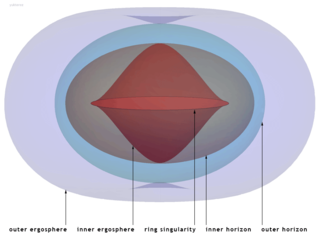
A black hole is a region of spacetime where gravity is so strong that nothing, including light and other electromagnetic waves, are capable of possessing enough energy to escape it. Einstein's theory of general relativity predicts that a sufficiently compact mass can deform spacetime to form a black hole. The boundary of no escape is called the event horizon. A black hole has a great effect on the fate and circumstances of an object crossing it, but it has no locally detectable features according to general relativity. In many ways, a black hole acts like an ideal black body, as it reflects no light. Moreover, quantum field theory in curved spacetime predicts that event horizons emit Hawking radiation, with the same spectrum as a black body of a temperature inversely proportional to its mass. This temperature is of the order of billionths of a kelvin for stellar black holes, making it essentially impossible to observe directly.

General relativity, also known as the general theory of relativity and Einstein's theory of gravity, is the geometric theory of gravitation published by Albert Einstein in 1915 and is the current description of gravitation in modern physics. General relativity generalises special relativity and refines Newton's law of universal gravitation, providing a unified description of gravity as a geometric property of space and time or four-dimensional spacetime. In particular, the curvature of spacetime is directly related to the energy and momentum of whatever matter and radiation are present. The relation is specified by the Einstein field equations, a system of second order partial differential equations.

A gravitational singularity, spacetime singularity or simply singularity is a condition in which gravity is predicted to be so intense that spacetime itself would break down catastrophically. As such, a singularity is by definition no longer part of the regular spacetime and cannot be determined by "where" or "when". Gravitational singularities exist at a junction between general relativity and quantum mechanics; therefore, the properties of the singularity cannot be described without an established theory of quantum gravity. Trying to find a complete and precise definition of singularities in the theory of general relativity, the current best theory of gravity, remains a difficult problem. A singularity in general relativity can be defined by the scalar invariant curvature becoming infinite or, better, by a geodesic being incomplete.
The no-hair theorem states that all stationary black hole solutions of the Einstein–Maxwell equations of gravitation and electromagnetism in general relativity can be completely characterized by only three independent externally observable classical parameters: mass, electric charge, and angular momentum. Other characteristics are uniquely determined by these three parameters, and all other information about the matter that formed a black hole or is falling into it "disappears" behind the black-hole event horizon and is therefore permanently inaccessible to external observers after the black hole "settles down". Physicist John Archibald Wheeler expressed this idea with the phrase "black holes have no hair", which was the origin of the name.
The Penrose–Hawking singularity theorems are a set of results in general relativity that attempt to answer the question of when gravitation produces singularities. The Penrose singularity theorem is a theorem in semi-Riemannian geometry and its general relativistic interpretation predicts a gravitational singularity in black hole formation. The Hawking singularity theorem is based on the Penrose theorem and it is interpreted as a gravitational singularity in the Big Bang situation. Penrose was awarded the Nobel Prize in Physics in 2020 "for the discovery that black hole formation is a robust prediction of the general theory of relativity", which he shared with Reinhard Genzel and Andrea Ghez.
A gravastar is an object hypothesized in astrophysics by Pawel O. Mazur and Emil Mottola as an alternative to the black hole theory. It has usual black hole metric outside of the horizon, but de Sitter metric inside. On the horizon there is a thin shell of matter. The term "gravastar" is a portmanteau of the words "gravitational vacuum star". Further theoretical considerations of gravastars include the notion of a nestar, or a second gravastar nested within the first one.
The Kerr metric or Kerr geometry describes the geometry of empty spacetime around a rotating uncharged axially symmetric black hole with a quasispherical event horizon. The Kerr metric is an exact solution of the Einstein field equations of general relativity; these equations are highly non-linear, which makes exact solutions very difficult to find.

An astrophysical jet is an astronomical phenomenon where outflows of ionised matter are emitted as extended beams along the axis of rotation. When this greatly accelerated matter in the beam approaches the speed of light, astrophysical jets become relativistic jets as they show effects from special relativity.
The Kerr–Newman metric is the most general asymptotically flat and stationary solution of the Einstein–Maxwell equations in general relativity that describes the spacetime geometry in the region surrounding an electrically charged and rotating mass. It generalizes the Kerr metric by taking into account the field energy of an electromagnetic field, in addition to describing rotation. It is one of a large number of various different electrovacuum solutions; that is, it is a solution to the Einstein–Maxwell equations that account for the field energy of an electromagnetic field. Such solutions do not include any electric charges other than that associated with the gravitational field, and are thus termed vacuum solutions.

The ergosphere is a region located outside a rotating black hole's outer event horizon. Its name was proposed by Remo Ruffini and John Archibald Wheeler during the Les Houches lectures in 1971 and is derived from the Greek word ἔργον (ergon), which means "work". It received this name because it is theoretically possible to extract energy and mass from this region. The ergosphere touches the event horizon at the poles of a rotating black hole and extends to a greater radius at the equator. A black hole with modest angular momentum has an ergosphere with a shape approximated by an oblate spheroid, while faster spins produce a more pumpkin-shaped ergosphere. The equatorial (maximal) radius of an ergosphere is the Schwarzschild radius, the radius of a non-rotating black hole. The polar (minimal) radius is also the polar (minimal) radius of the event horizon which can be as little as half the Schwarzschild radius for a maximally rotating black hole.
In physics, there is a speculative hypothesis that, if there were a black hole with the same mass, charge and angular momentum as an electron, it would share other properties of the electron. Most notably, Brandon Carter showed in 1968 that the magnetic moment of such an object would match that of an electron. This is interesting because calculations ignoring special relativity and treating the electron as a small rotating sphere of charge give a magnetic moment roughly half the experimental value.
A ring singularity or ringularity is the gravitational singularity of a rotating black hole, or a Kerr black hole, that is shaped like a ring.

The Penrose process is theorised by Sir Roger Penrose as a means whereby energy can be extracted from a rotating black hole. The process takes advantage of the ergosphere – a region of spacetime around the black hole dragged by its rotation faster than the speed of light, meaning that from the point of view of an outside observer any matter inside is forced to move in the direction of the rotation of the black hole.

Stellar rotation is the angular motion of a star about its axis. The rate of rotation can be measured from the spectrum of the star, or by timing the movements of active features on the surface.

Gamma-ray burst progenitors are the types of celestial objects that can emit gamma-ray bursts (GRBs). GRBs show an extraordinary degree of diversity. They can last anywhere from a fraction of a second to many minutes. Bursts could have a single profile or oscillate wildly up and down in intensity, and their spectra are highly variable unlike other objects in space. The near complete lack of observational constraint led to a profusion of theories, including evaporating black holes, magnetic flares on white dwarfs, accretion of matter onto neutron stars, antimatter accretion, supernovae, hypernovae, and rapid extraction of rotational energy from supermassive black holes, among others.
The following outline is provided as an overview of and topical guide to black holes:
The BTZ black hole, named after Máximo Bañados, Claudio Teitelboim, and Jorge Zanelli, is a black hole solution for (2+1)-dimensional topological gravity with a negative cosmological constant.
The Blandford–Znajek process is a mechanism for the extraction of energy from a rotating black hole, introduced by Roger Blandford and Roman Znajek in 1977. This mechanism is the most preferred description of how astrophysical jets are formed around spinning supermassive black holes. This is one of the mechanisms that power quasars, or rapidly accreting supermassive black holes. Generally speaking, it was demonstrated that the power output of the accretion disk is significantly larger than the power output extracted directly from the hole, through its ergosphere. Hence, the presence of a poloidal magnetic field around the black hole is not determinant in its overall power output. It was also suggested that the mechanism plays a crucial role as a central engine for a gamma-ray burst.

Gravitoelectromagnetism, abbreviated GEM, refers to a set of formal analogies between the equations for electromagnetism and relativistic gravitation; specifically: between Maxwell's field equations and an approximation, valid under certain conditions, to the Einstein field equations for general relativity. Gravitomagnetism is a widely used term referring specifically to the kinetic effects of gravity, in analogy to the magnetic effects of moving electric charge. The most common version of GEM is valid only far from isolated sources, and for slowly moving test particles.
Frame-dragging is an effect on spacetime, predicted by Albert Einstein's general theory of relativity, that is due to non-static stationary distributions of mass–energy. A stationary field is one that is in a steady state, but the masses causing that field may be non-static — rotating, for instance. More generally, the subject that deals with the effects caused by mass–energy currents is known as gravitoelectromagnetism, which is analogous to the magnetism of classical electromagnetism.













